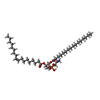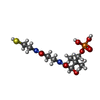+Search query
-Structure paper
| Title | Cryo-EM Structures and Regulation of Arabinofuranosyltransferase AftD from Mycobacteria. |
|---|---|
| Journal, issue, pages | Mol Cell, Vol. 78, Issue 4, Page 683-699.e11, Year 2020 |
| Publish date | May 21, 2020 |
 Authors Authors | Yong Zi Tan / Lei Zhang / José Rodrigues / Ruixiang Blake Zheng / Sabrina I Giacometti / Ana L Rosário / Brian Kloss / Venkata P Dandey / Hui Wei / Richard Brunton / Ashleigh M Raczkowski / Diogo Athayde / Maria João Catalão / Madalena Pimentel / Oliver B Clarke / Todd L Lowary / Margarida Archer / Michael Niederweis / Clinton S Potter / Bridget Carragher / Filippo Mancia /     |
| PubMed Abstract | Mycobacterium tuberculosis causes tuberculosis, a disease that kills over 1 million people each year. Its cell envelope is a common antibiotic target and has a unique structure due, in part, to two ...Mycobacterium tuberculosis causes tuberculosis, a disease that kills over 1 million people each year. Its cell envelope is a common antibiotic target and has a unique structure due, in part, to two lipidated polysaccharides-arabinogalactan and lipoarabinomannan. Arabinofuranosyltransferase D (AftD) is an essential enzyme involved in assembling these glycolipids. We present the 2.9-Å resolution structure of M. abscessus AftD, determined by single-particle cryo-electron microscopy. AftD has a conserved GT-C glycosyltransferase fold and three carbohydrate-binding modules. Glycan array analysis shows that AftD binds complex arabinose glycans. Additionally, AftD is non-covalently complexed with an acyl carrier protein (ACP). 3.4- and 3.5-Å structures of a mutant with impaired ACP binding reveal a conformational change, suggesting that ACP may regulate AftD function. Mutagenesis experiments using a conditional knockout constructed in M. smegmatis confirm the essentiality of the putative active site and the ACP binding for AftD function. |
 External links External links |  Mol Cell / Mol Cell /  PubMed:32386575 / PubMed:32386575 /  PubMed Central PubMed Central |
| Methods | EM (single particle) |
| Resolution | 2.9 - 3.5 Å |
| Structure data | EMDB-21580, PDB-6w98: EMDB-21600, PDB-6wbx: EMDB-21601, PDB-6wby: |
| Chemicals |  ChemComp-CA:  ChemComp-6OU:  ChemComp-PNS:  ChemComp-HOH: |
| Source |
|
 Keywords Keywords | MEMBRANE PROTEIN / Glycosyltransferase / lipomannan / lipoarabinomannan / arabinofuranose / nanodisc / single-particle cryo-electron microscopy / acyl carrier protein |
 Movie
Movie Controller
Controller Structure viewers
Structure viewers About Yorodumi Papers
About Yorodumi Papers










